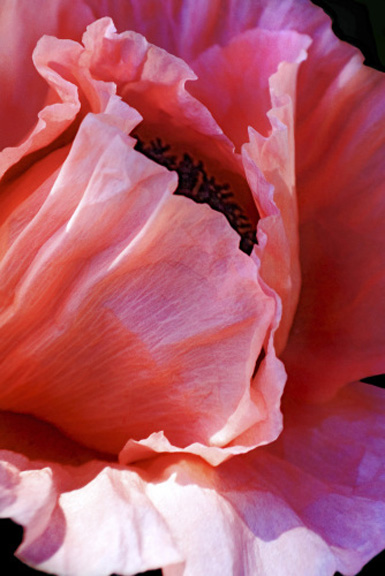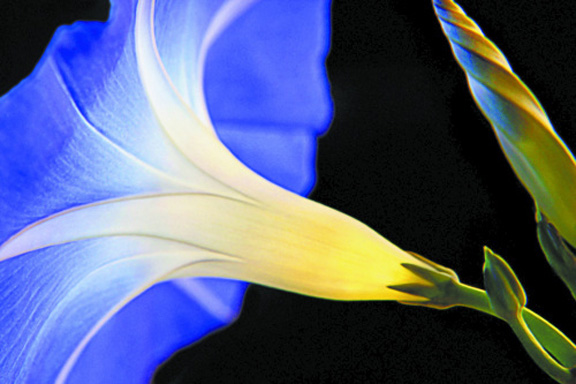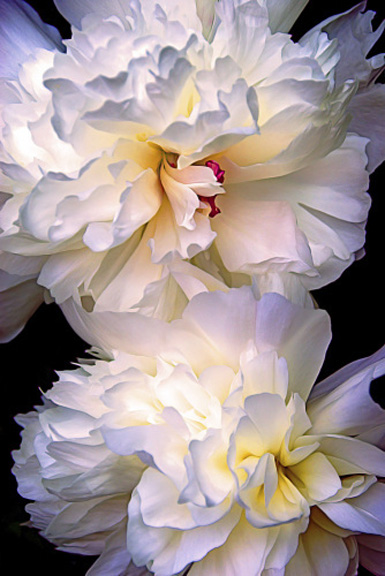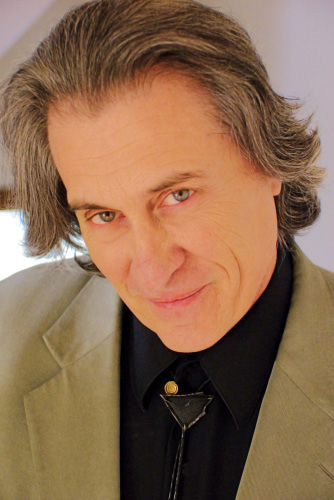Virtual Gardener: John Steffl, “Hybrids”
John Steffl, a longtime ceramicist and painter, several years ago became a digital photographer, working with flowers. A show of this work just opened at Lizzards Gallery in Duluth (through Sept. 15). Here's the story . . . .





“There are not many days in the life of a peony,” says John Steffl, the erstwhile painter now a digital photographer.
When Steffl was going through round after round of chemotherapy for lymphoma a couple of years ago, he thought perhaps there weren’t so many days in his life either. The flowers were close, beckoning and, to eyes made new by the nearness of death, they were “so beautiful that they were sacred.”
“June [2004] was the first month of my chemotherapy,” Steffl recalls. “I was out in the garden and the beauty of the flowers struck me, especially in my weakened state — and the sensuality of them [because] the experience of chemo is the least sensual thing in the world.”
Steffl had just bought a digital camera and began photographing flowers. “Hybrids,” the distilled results of three years of work, opened August 16 at Lizzards Art Gallery, 11 W. Superior St.
First, a respite
Steffl, the former artistic director of the Duluth Art Institute, had never paid much attention to flowers before his illness.
“Peering down into these beautiful forms led my mind into a calmer place — they are, you know, mandalas. They have labyrinthine depths and possibilities, leading to a center point. They would take my pain and take my anxiety and pull it down into depths . . . . ” he said, his voice trailing off.
“It became how I chose to deal with the suffering — hours of sucking up toxic chemicals, hours crouched over the toilet puking my guts out. People ask me why I do these and I say, ‘They’re a distraction.’ Well, distraction is how I learn things. Being anti-authoritarian, when someone tells me to look at something I’ll look at something else instead.”
So the flowers became a way to transform pain and suffering, fear and revulsion into something else.
Steffl, 58, tells another story, this one from further on in his illness and recovery. After exploratory surgery, his long abdominal incision had become infected. The open wound, a red line in white skin, revolted him. Walking through Park Hill Cemetery (a frequent stroll in those days) he saw, nearly buried in foliage, a white bloom — a magnificent peony. Lifting it from its matted surrounding, he saw its white petals were edged with red. In that instant, it was his insulted flesh, but it also was deeply beautiful.
That identity, that epiphany, became one of the chords of his work in “Hybrids.” It was the doubleness that gave complexity and depth to what had been simply a welcome respite from pain and terror.
Abstract garden
Since that epiphany, Steffl has studied techniques of digital photography intensely. The photos in the show are not “raw” — not simply images of the flowers the way they appeared under the sun. He loads the photos into his computer and works on the digital images for hours, sometimes spending days bringing a single flower further into the form that seems right for it, that coincides with his developing knowledge of both the original flower and the artwork it is to become. This is another aspect to the title “Hybrids”: the works are both images of particular flowers and abstract works.
But Steffl doesn’t want to impose meanings on the images. Their spare and plain titles — “Morning Glory with Buds” or “Blue Pansy” — bear this out.
“I was trying to stay away from laying my interpretations on people,” he says. “People can bring their own experiences to the work and make their own meanings. That’s something my [former] clay work, my paintings and these photographs have in common: I’ve worked abstractly and expressively for 35 years, and even though I use imagery now, I hope the work is open to its viewers, open to their meanings.”
Steffl has no garden of his own. Or rather, his “garden” is those flowers and plants that spring up without his intention, like the blue forget-me-nots and orange hawkweed in his backyard that he carefully mows around.
“Big irony, I suffer terribly from hay fever, but I’ve come to believe that there are no weeds,” he says.
The gardens of others, though, often impress him, and it is in those gardens that he gathers his images. “It seems wonderful to me that there are people who add things to the world instead of only taking,” he says. “…The ability and willingness of people to put their hands in the earth and to tend and nurture things — I’d like to see those values reinforced.”
Foreboding is part of Steffl’s nature. “There’s an interest to the dark side of things, the gnawing anxiety, it does something to the intensity of how I see things,’’ he says.
But that cloud can be lifted by the persistent efforts of those whose intentions are constructive and nurturing, like gardeners, or like the nurses who worked at the infusion center where his chemotherapy was administered, whose solicitude and competent tenderness Steffl remembers with gratitude. His take on the world has often been dark, but paradoxically, his experiences during these past years have provided many sources of light, and many experiences of beauty.
“I went from being very physical, working on big sculptures, big paintings, to doing this, sitting in a chair eight hours a day, clicking a mouse. A huge adaptation. I owe that to cancer and chemotherapy, the resulting changes it’s offered me.’’
Steffl speaks of what “transubstantiation” means for him: “transforming pain and fear into a universal resonance. I have my doubts about religion, but one of the gifts my Catholic upbringing left me with was the ability to see beauty and sacredness in the world. When I was growing up, practically everything had its symbols and attributes. Why wouldn’t I look at a flower and see a pathway to heaven?”
This story was first published in the Duluth News-Tribune. It is reprinted here by permission.